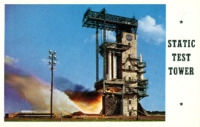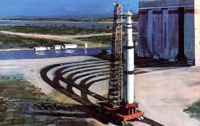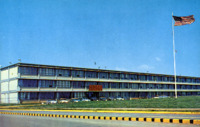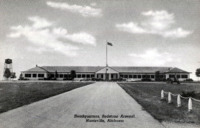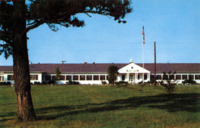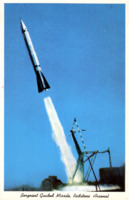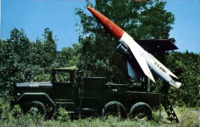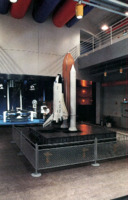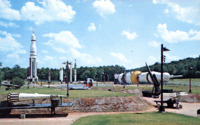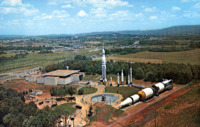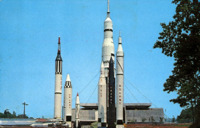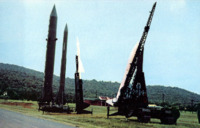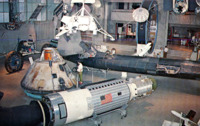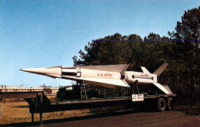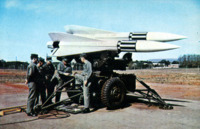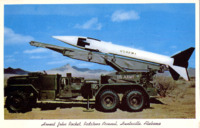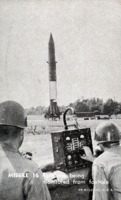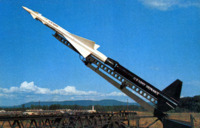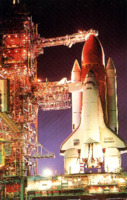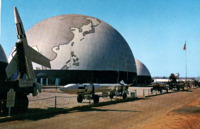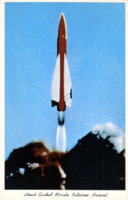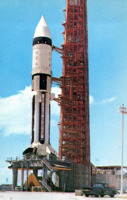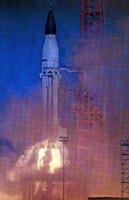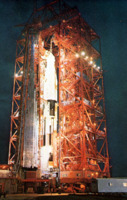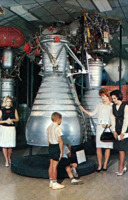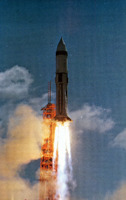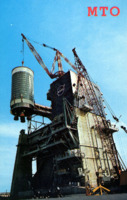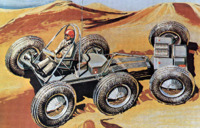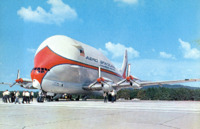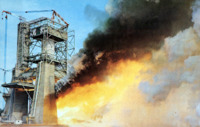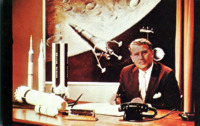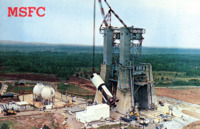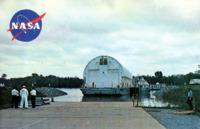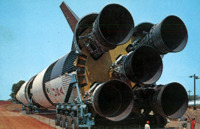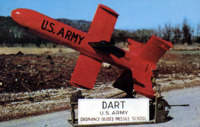
Browse Items (513 total)
Sort by:
-
Static Firing Test Tower
Front: Static Test Tower.
Back: STATIC FIRING TEST TOWER, MARSHALL SPACE FLIGHT CENTER
The Saturn booster undergoes static firing at the NASA George C. Marshall Space Flight Center, Huntsville, Alabama. The booster has been successfully static fired many times prior to the launching of the first Saturn from Cape Canaveral, Florida on October 27, 1961. The same tower has been used for Redstone and Jupiter programs. Static testing of a missile consists of locking the missile into place on the stand and firing it. The missile does not "take off", but as it strains against the mighty grip of the great tower its roaring engine can be studied for performance characteristics as if it were actually in flight. -
Artist's Conception of Saturn V/Apollo Being Transported on Crawler
Back: Artist's conception of Saturn V/Apollo being transported on crawler the size of a baseball infield, to the launch area at Mila, John F. Kennedy Space Center. The NASA Marshall Space Flight Center at Huntsville, Alabama, has been developing and providing rockets for our space achievements since the very beginning of our entry into this field. -
Missile and Maintenance Center and School at Redstone Arsenal
Back: Headquarters and school of the Missile and Maintenance Center and School at Redstone Arsenal near Huntsville, Alabama. -
U.S. Army Ordnance Missile Command Headquarters
Back: HEADQUARTERS BUILDING, U.S. ARMY ORDNANCE MISSILE COMMAND
Here all of the U.S. Army's rocket and guided missile and space programs are controlled, under the direction of Maj. Gen. J. B. Medaris. -
Headquarters, Redstone Arsenal
Front: Headquarters, Redstone Arsenal, Huntsville, Alabama. -
Redstone Aresenal
Back: REDSTONE ARSENAL southwest of Huntsville, Alabama.
Site of the nation's largest ordnance, rocket, and guided missile research. -
Sergeant Guided Missile
Front: Sergeant Guided Missile, Redstone Arsenal.
Back: SERGEANT GUIDED MISSILE, REDSTONE ARSENAL, HUNTSVILLE, ALABAMA.
Measuring about 30 feet in length, the Army's Sergeant is a surface-to-surface, solid propellant, ballistic guided missile possessing a very high degree of reliability and accuracy. Also highly mobile, it can be quickly emplaced and fired by a very small crew, under all conditions of weather and terrain, delivering a nuclear blow far behind enemy lines. Its highly accurate guidance system is invulnerable to ony known means of enemy counter-measures. -
Lacrosse Guided Missile
Back: LACROSSE GUIDED MISSILE, REDSTONE ARSENAL, HUNTSVILLE, ALABAMA.
An Army surface-to-surface artillery guided missile. The Lacrosse system consists of three basic units the missile, which is a solid fuel rocket, a launcher mounted on a standard Army truck, and a guidance station. The Lacrosse is capable of delivering a variety of warheads, at the direction of the combat commander, with precision accuracy. -
Spacedome Lobby
Back: SPACEDOME LOBBY, Huntsville, Ala. A large Space Shuttle model is dramatically displayed in the lobby of the Spacedome theater which features space and science films. The Spacedome adjoins Earths Largest Space Museum at the Space & Rocket Center. -
Alabama Space and Rocket Center
Back: ALABAMA SPACE AND ROCKET CENTER. America's largest Missile and Space Exhibit. Tranquility Base, Huntsville, Alabama 35807. The Alabama Space and Rocket Center is the largest missile and space exhibit in the world. It was dedicated by the citizens of Alabama to those Americans who made it possible for man to walk on the moon and to explore the universe; and to the youth of America who will utilize space technology for the benefit of mankind. -
Alabama Space and Rocket Center
Back: The Alabama Space and Rocket Center contains the world's largest collection of missiles, rockets, and space vehicles. A full scale Apollo Saturn V moon rocket is exhibited in a horizontal position and is one of the featured attractions on the 35 acre complex. The exhibition Center is owned and operated by the State of Alabama and is opened every day, located west of downtown Huntsville on Alabama Highway 20. -
Alabama Space and Rocket Center
Back: ALABAMA SPACE AND ROCKET CENTER. America's Largest Missile and Space Exhibit, Tranquility Base, Huntsville, Alabama 35807. The Rocket Park consists of the world's largest collection of rockets and space vehicles on display to the general public. From left to right, visitors view the Mercury / Atlas , Mercury / Redstone, Jupiter, V-2, Juno II, Saturn I, Redstone, Jupiter C. -
Guided Missiles
Back: THE REDSTONE, CORPORAL, NIKE-AJAX AND HONEST JOHN GUIDED MISSILES REDSTONE ARSENAL, HUNTSVILLE, ALABAMA. Redstone Arsenal is the Army Ordnance research and development center for rockets and guided missiles. It is here where the army developed its guided missiles, including the mighty Jupiter C, which launched the Explorer, the United States first Earth Satellite. -
Alabama Space and Rocket Center Exhibits
Back: Spaceships, moon buggies, rocket engines and exhibits about space travel fill the multi-million dollar Alabama Space and Rocket Center in Huntsville. The new space center, World's largest missile and space exhibit, highlights the equipment used by U. S. astronauts to explore the moon. The Center is located west of Huntsville on Highway 20, and operates seven days a week. -
Missile Display & Public Picnic Area
Back: MISSILE DISPLAY & PUBLIC PICNIC AREA, Redstone Arsenal, Alabama.
This is one of the many outdoor displays provided to enlighten, encourage and inspire visitors to the area. Sights like this, provide a feeling of safety and security that you can't purchase with a can of insecticide. -
Zeus Missile
Back: ARMY'S ZEUS MISSILE AGAINST AN OLD SOUTHERN BACKGROUND
A Zeus Missile - part of the Army's Nike-X Anti-Missile System - is posed in front of the Goddard House at Redstone Arsenal, Ala., home of the U. S. Army Missile Command. The Goddard House is an old plantation house taken over by the Army when the Arsenal was established near Huntsville in 1941. -
Hawk Anti-Aircraft Missile
Back: Field exercise maintainance of Hawk anti-aircraft missile at Missile and Munitions Center and School at Redstone Arsenal near Huntsville, Ala. -
Honest John Rocket
Front: Honest John Rocket, Redstone Arsenal, Huntsville, Alabama.
Back: HONEST JOHN ROCKET, REDSTONE ARSENAL
Capable of carrying both atomic and high explosive warheads, this long-range Army artillery rocket is used tactically to provide close fire support to ground combat operations. The weapon has considerably more battlefield mobility than conventional artillery and one high explosive round can deliver on the target, the demolition effect of hundreds of artillery shells. -
Missile 16 Redstone
Front: Missile 16 Redstone being monitored from foxhole. -
U.S. Army Ordnance "Nike" Guided Missile
Back: U.S. ARMY ORDNANCE "NIKE" GUIDED MISSILE, HUNTSVILLE, ALABAMA
Home of Redstone Arsenal, the Army Ordnance Rocket and Guided Missile Center. The Nike was America's first operational guided missile. Named after the Goddess of Victory, this weapon provides the first line of defense against atomic attack. -
Space Shuttle Challenger Prior to Launch
Back: Kennedy Space Center, FL. Space Shuttle Challenger, Mission 41-B, on pad prior to launch. -
U.S. Army Missile Display Area
Back: U.S. ARMY MISSILE DISPLAY AREA, Redstone Arsenal, Alabama
The massive domes house innumerable displays, individual listening devices describe and explain the functions of various Rockets and Missiles. Buttons and levers operate miniature models and allow visitors to play Astronaut. The large dome is 150' in diameter and 85' tall. It is made of vinyl coated nylon, and is kept erect by air pressure. The nylon in this one dome weighs 92,000 lbs. -
Hawk Guided Missle
Front: Hawk Guided Missile, Redstone Arsenal.
Back: HAWK GUIDED MISSILE, REDSTONE ARSENAL, HUNTSVILLE, ALABAMA
This it the Army's versatile surface-to-air guided missile, designed for protection against low altitude attack. Carrying a lethal warhead, this air defense weapon system is capable of destroying attackers flying at the lowest altitudes, at ranges insuring effective protection of defended areas. Highly mobile, the system is capable of being transported with a minimum number of vehicles on the highway, by helicopter, and by aircraft. -
Uprated Saturn I Launch at Cape Kennedy
Back: The second Uprated Saturn I launch vehicle (designated AS-203) stands on the launch pad at Cape Kennedy. Blunt nosecone replaced the Apollo spacecraft for this special flight. This was a liquid hydrogen test to determine how liquid hydrogen reacted in space. Television comeras were in the top of the second stage's liquid hydrogen tank. The Saturn was developed at MSFC, Huntsville, AIabama. -
Fifth Saturn I Launch at Cape Kennedy
Back: The fifth Saturn I launch vehicle (SA-5) leaves the launch pad at Cape Kennedy, Fla., on Jan. 29, 1964. Nose cone painted black for special thermal experiment. -
Uprated Saturn I Launch Vehicle
Back: The Uprated Saturn I launch vehicle (SA-202) is surrounded by the service structure on the launch pad at the NASA - Kennedy Space Center, Fla. The Marshall Center, Huntsville, Ala., developed the Saturn launch vehicle. -
Marshall Space Flight Center's Space Orientation Center
Back: HUNTSVILLE, ALABAMA. NASA - Marshall Space Flight Center's Space Orientation Center. Rocket engine exhibits and other space-age displays are exhibited at the MSFC Space Orientation Center. -
Launch of Saturn I
Back: The second Uprated Saturn I launch vehicle (designated AS-203) leaves the launch pod at Cape Kennedy, Fla., on July 5, 1966. Saturn was developed at MSFC, Huntsville, Alabama. -
Mississippi Test Operations Test Stand
Front: MTO
Back: A ground test modal of the Saturn V second stage (S-ll ) is lifted into a recently completed captive test stand at the Mississippi Test Operations in Hancock County, Miss. The NASA-Marshall Space Flight Center's Mississippi Test Operations will be used for captive firing the S-ll flight stages. Ground test stage was manufactured to test out S-ll systems and the ground test facilities. -
Saturn I Launch
Front: Saturn I
Back: The eighth Saturn I launch vehicle launched from the NASA-Kennedy Space Center, Fla., (vehicle designated SA-9) is shown leaving the launch pad on Feb. 16,1965. The Saturn was developed at Marshall Space Center, HuntsviIle, Alabama. -
Artist's Drawing of Proposed Lunar Vehicle
Back: This is on artist's drawing of the six wheel General Motors built Mobility Test Article. The vehicle is being built by GM and tested by NASA. The concept will be used to design a vehicle for use on the moon. MSFC, at Redstone Arsenal, directs the work. -
Super Guppy Aircraft
Back: Super Guppy aircraft, operated under NASA contract and owned by Aero-Space Lines, Inc., Van Nuys, Calif. Used to haul Saturn S-IVB stage from West Coast to Cape Kennedy. Also used to carry other large rocket stages and components. -
Michoud Assembly Facility
Back: This is the assembly floor at the NASA - Michoud Assembly facility at New Orleans, La. The large assembly building has some 40 acres under one roof. Boosters shown here are first stages for the Uprated Saturn I launch vehicle. The Saturn was developed at Marshall Space Center, Huntsville, Alabama. -
Artist's Conception of Saturn V Flight
Back: This is on artist's conception of the Apollo/Saturn V vehicle leaving on the first leg of the moon journey. The three stage vehicle will be launched from Cape Kennedy, Fla. and will carry three astronauts to the moon and back. The Saturn was developed at MSFC, Huntsville, Alabama. -
Static Test of Saturn V First Stage
Back: The 7.5 million pound thrust Saturn V first stage is static tested at the NASA-Marshall Space Flight Center in Huntsville, Ala. Five F-l engines power the stage. The stage will be the booster for the first Saturn V launched. This vehicle is scheduled for launch this year (1967). -
Dr. Wernher von Braun
Back: Dr. Wernher von Braun, director of the NASA - Marshall Space Flight Center, is shown with rocket models and hardware at the Huntsville, Alabama space installation. -
Saturn V Test Stand
Front: MSFC
Back: The first flight Saturn V booster is shown being hauled into a giant test stand at NASA - MarshalI Space Flight Center, Huntsville, Alabama (Redstone Arsenal). The booster will be captive fired here. Stage's five F-1 engines produce 7.5 million pounds thrust. -
George C. Marshall Space Flight Center
Back: The George C. Marshall Space Flight Center (MSFC), Huntsville, Alabama
Saturn rocket booster barge at dock on Tennessee River. Barge is used to carry boosters from MSFC at Redstone Arsenal, Ala., to NASA - Kennedy Space Center, Fla., for launch. -
Alabama Space and Rocket Center
Back: ALABAMA SPACE AND ROCKET CENTER
America's Largest Missile and Space Exhibit. Tranquility Base, Huntsville, Alabama 35807.
The full-size Apollo Saturn V moon rocket is one of the feature attractions at the Alabama Space and Rocket Center. The five huge rocket engines develop seven and one half million pounds of thrust and consume propellents at the rate of 5,000 gallons per second. The complete vehicle - longer than a baseball field - can be viewed close up by the visitor. The Alabama Space and Rocket Center tells the story of man's past, present, and future efforts to explore space for peaceful purposes. -
Dare Anti-Tank Guided Missile
Back: DART ANTI-TANK GUIDED MISSILE, REDSTONE ARSENAL, HUNTSVILLE, ALABAMA
This vehicle-launched, rocket propelled guided missile is designed for use by front line troops. It requires a minimum of technical training to operate, yet carries a warhead capable of defeating the heaviest known enemy armor. This versatile Army missile can deliver its warhead with pinpoint accuracy.
